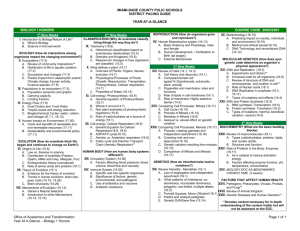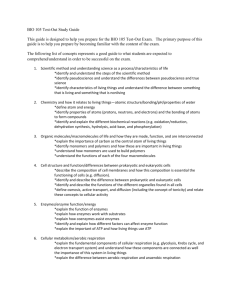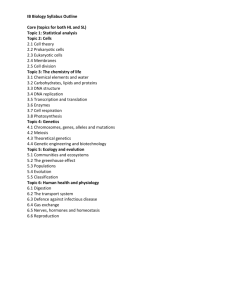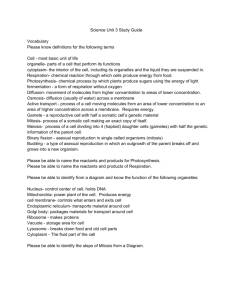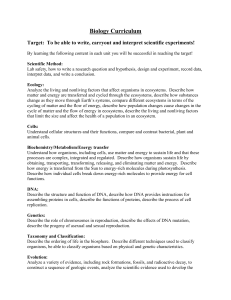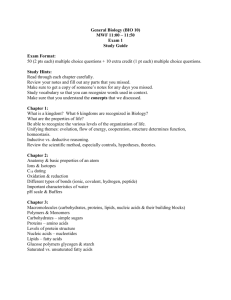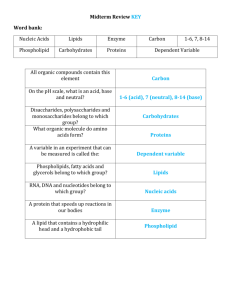EOC Study Guide - Somerset Independent Schools
advertisement
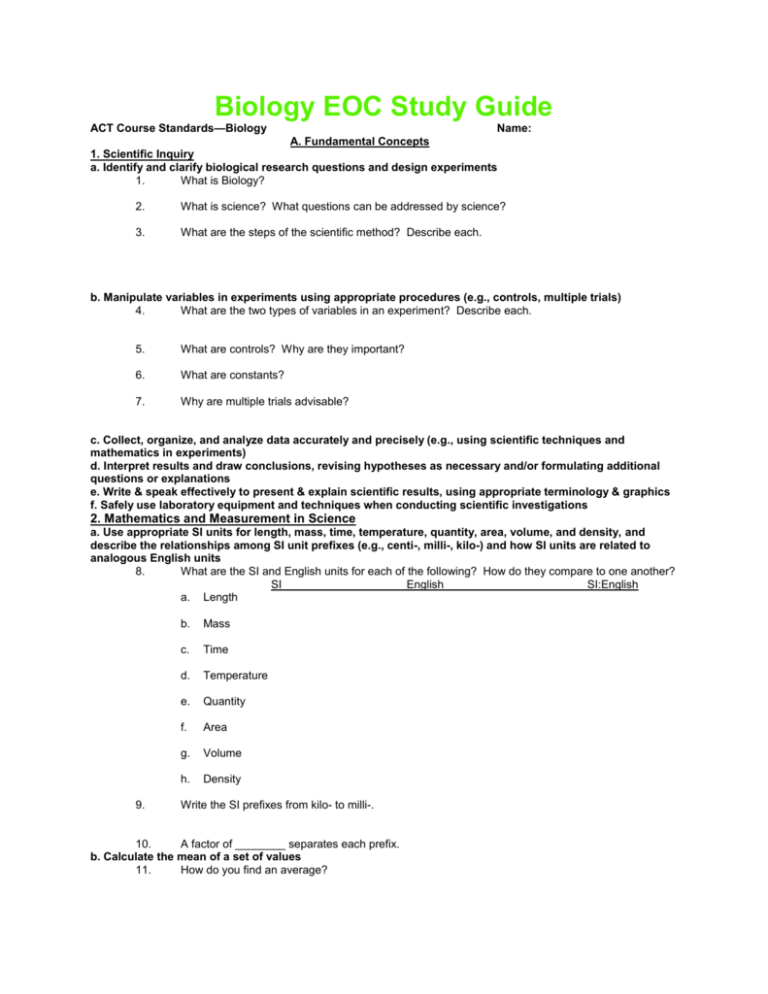
Biology EOC Study Guide ACT Course Standards—Biology Name: A. Fundamental Conceptsf Biology 1. Scientific Inquiry a. Identify and clarify biological research questions and design experiments 1. What is Biology? 2. What is science? What questions can be addressed by science? 3. What are the steps of the scientific method? Describe each. b. Manipulate variables in experiments using appropriate procedures (e.g., controls, multiple trials) 4. What are the two types of variables in an experiment? Describe each. 5. What are controls? Why are they important? 6. What are constants? 7. Why are multiple trials advisable? c. Collect, organize, and analyze data accurately and precisely (e.g., using scientific techniques and mathematics in experiments) d. Interpret results and draw conclusions, revising hypotheses as necessary and/or formulating additional questions or explanations e. Write & speak effectively to present & explain scientific results, using appropriate terminology & graphics f. Safely use laboratory equipment and techniques when conducting scientific investigations 2. Mathematics and Measurement in Science a. Use appropriate SI units for length, mass, time, temperature, quantity, area, volume, and density, and describe the relationships among SI unit prefixes (e.g., centi-, milli-, kilo-) and how SI units are related to analogous English units 8. What are the SI and English units for each of the following? How do they compare to one another? SI English SI:English a. Length 9. b. Mass c. Time d. Temperature e. Quantity f. Area g. Volume h. Density Write the SI prefixes from kilo- to milli-. 10. A factor of ________ separates each prefix. b. Calculate the mean of a set of values 11. How do you find an average? c. Use graphical models, mathematical models, and simple statistical models to express patterns and relationships determined from sets of scientific data 3. Science in Practice a. Describe the fundamental assumptions of science 12. What are the fundamental assumptions of science? b. Assess how scientific and technological progress has affected other fields of study, careers, and aspects of everyday life 13. Give several examples of how science and technology have affected other areas of life. c. Recognize and apply criteria that scientists use to evaluate the validity of scientific claims and theories 14. What are some good ways to determine whether a scientific claim is valid? d. Explain why scientific explanations must meet certain criteria (e.g., be consistent with experimental/observational evidence about nature, be open to critique and modification, be subject to peer review, use ethical reporting methods and procedures) e. Explain why all scientific knowledge is subject to change as new evidence becomes available to the scientific community 15. Why is all scientific knowledge subject to change? f. Use a variety of appropriate sources (e.g., Internet, scientific journals) to retrieve relevant information; cite references properly g. Compare the goals and procedures followed in basic science with the goals and procedures of applied science and technology; discuss the important contributions of each and how citizens need to understand the ramifications of funding both endeavors 16. How do the goals of basic science and technology different? Why are both important? h. Explain how the contributions of basic science drive the potential of applied science (e.g., advantages found in nature can be emulated for our own benefit/product development, such as observations of gecko feet suggesting new adhesives; understanding of basic cell biology leading to cancer treatments) 4. Foundations a. Describe the biological criteria that need to be met in order for an organism to be considered alive 17. What are the characteristics for life? b. Define and provide examples of each level of organization (e.g., biosphere, biome, ecosystem, community, population, multicellular organism, organ system, organ, tissue, cell, organelle, molecule, atom, subatomic particle) 18. Know the levels of organization listed above. Provide examples for each level of organization. c. Design and conduct investigations appropriately using essential processes of scientific inquiry 19. Why is it better to have more subjects involved in a study than fewer? d. Use mathematics to enhance the scientific inquiry process (e.g., choosing appropriate units of measurement, graphing and manipulating experimental data) 20. What unit would be used to measure the length of different types of bacteria? 5. Biochemistry a. Identify subatomic particles and describe how they are arranged in atoms 21. What are the parts of an atom, their charges, and sizes? 22. How are the subatomic particles arranged? b. Describe the difference between ions and atoms and the importance of ions in biological processes 23. What is an ion? 24. Give some examples of how ions are used in organisms. c. Compare the types of bonding between atoms to form molecules 25. Describe the following types of bonds and give an example of their use in organisms. a. covalent b. ionic c. hydrogen d. Show how chemical reactions (e.g., photosynthesis, fermentation, cellular respiration) can be represented by chemical formulas 26. What is the chemical formula for photosynthesis? 27. What is the chemical formula for lactic acid and alcoholic fermentation? 28. What is the chemical formula for cellular respiration? e. Explain the difference between organic and inorganic compounds 29. What element do all organic compounds share? 30. What does organic and inorganic mean? f. Explain the fundamental principles of the pH scale and the consequences of having the different concentrations of hydrogen and hydroxide ions 31. Write the pH scale below. Label which part of the scale is acidic, basic, and neutral. Label which part is the result of hydrogen ions and hydroxide ions. g. Describe the general structure and function(s), including common functional groups, of monosaccharides, disaccharides, polysaccharides, carbohydrates, fatty acids, glycerol, glycerides, lipids, amino acids, dipeptides, polypeptides, proteins, and nucleic acids 32. What is a monosaccharide? Give an example and draw it. 33. What is a disaccharide? Give an example and draw it. 34. What is a polysaccharide? 35. What polysaccharide is used as long-term energy storage in animals? 36. What polysaccharide is used as long-term energy storage in plants? 37. What polysaccharide is used for structure in plants? 38. What are carbohydrates? What are they used for? 39. What are fatty acids? What shape are they? 40. What is glycerol? What shape is it? 41. What are glycerides? 42. What are lipids? What are they used for? 43. What are amino acids? What is the general structure of amino acids? How many are there? 44. What are dipeptides? 45. What are polypeptides? 46. What are proteins? How are they different from polypeptides? 47. How are proteins used in living things? 48. What are nucleic acids? What are they made of? 49. What are the parts of a nucleotide? Draw it. h. Describe the function of enzymes, including how enzyme-substrate specificity works, in biochemical reactions 50. What is an enzyme? What do enzymes do? 51. What is a substrate? 52. Draw a chemical reaction catalyzed by an enzyme. 53. What factors can affect how well or how fast an enzyme works? i. Define and explain the unique properties of water that are essential to living organisms 54. What is the chemical formula for water? Draw a water molecule. 55. What is a polar molecule? Why is water polar? 56. What is surface tension? 57. What is capillary action? How is it important to living things? j. Explain how cells store energy temporarily as ATP 58. What is ATP? 59. Draw ATP. 60. How does ATP release energy? Draw it. B. Cell Processes 1. Cells a. Analyze the similarities and differences among (a) plant versus animal cells and (b) eukaryotic versus prokaryotic cells 61. What are some differences between plant and animal cells? 62. What is the difference between prokaryotic and eukaryotic cells? b. Describe the functions of all major cell organelles, including nucleus, ER, RER, Golgi apparatus, ribosome, mitochondria, microtubules, microfilaments, lysosomes, centrioles, and cell membrane 63. Give the structure and function of each of the following organelles. a. nucleus b. SER c. RER d. Golgi apparatus e. ribosome f. mitochondria g. microtubules h. Microfilaments i. lysosomes j. centrioles k. cell membrane c. Illustrate how all cell organelles work together by describing the step-by-step process of the translation of an mRNA strand into a protein and its subsequent processing by organelles so that the protein is appropriately packaged, labeled, and eventually exported by the cell 64. Describe transcription and mRNA processing in detail. 65. Describe translation in detail. 66. Describe protein processing and export in detail. d. Contrast the structure and function of subcellular components of motility (e.g., cilia, flagella, pseudopodia) 67. What are cilia? How are they used? 68. What are flagella? What is its structure and how is it used? 69. What are pseudopodia? What organisms use pseudopodia? e. Explain how the cell membrane controls movement of substances both into and out of the cell and within the cell f. Explain how the cell membrane maintains homeostasis 70. How does the cell membrane maintain homeostasis? g. Describe and contrast these types of cell transport: osmosis, diffusion, facilitated diffusion, and active transport 71. What is diffusion? 72. What is osmosis? 73. What substances can diffuse across the cell membrane freely? 74. What is passive transport? 75. What is active transport? Describe the types of active transport. h. Identify the cellular sites of and follow through the major pathways of anaerobic and aerobic respiration, compare reactants and products for each process, and account for how aerobic respiration produces more ATP per monosaccharide 76. Describe aerobic respiration in detail. 77. Describe anaerobic respiration (fermentation) in detail. i. Explain how photosynthetic organisms use the processes of photosynthesis and respiration 78. Why do plants have to do both photosynthesis and cellular respiration? How do they work together? j. Describe the basic process of mitosis 79. Describe mitosis in detail. C. Heredity 1. Genetics a. Describe the basic structure and function of DNA, mRNA, tRNA, amino acids, polypeptides, and proteins (e.g., replication,transcription, and translation) 80. What is the structure and function of DNA? 81. What is the structure and function of mRNA? 82. What is the structure and function of tRNA? 83. Describe DNA replication in detail. b. Describe the experiments of major scientists in determining both the structure of DNA and the central dogma 84. What discovered the structure of DNA? How (who helped)? In what year? 85. Describe the experiments that led up to determining that DNA was the genetic material. c. Use mRNA codon charts to determine amino acid sequences of example polypeptides 86. Use a mRNA codon chart to give the amino acid sequence of the following mRNA strand. AUGCCGUACGGG d. Use mRNA codon charts to determine the effects of different types of mutations on amino acid sequence and protein structure (e.g., sickle cell anemia resulting from base substitution mutation) e. Describe how gene expression is regulated in organisms such that specific proteins are synthesized only when they are needed by the cell (e.g., allowing cell specialization) 87. What is gene expression? 88. Give examples of how gene expression is used for cell specialization and throughout an organism’s life. f. Describe the basic process of meiosis 89. Describe meiosis in detail. 90. Compare and contrast mitosis and meiosis. g. Identify and explain Mendel’s law of segregation and law of independent assortment 91. What is the Law of Segregation? How is it achieved by the cell? 92. What is the Law of Independent Assortment? How is it achieved by the cell? h. Explain how the process of meiosis reveals the mechanism behind Mendel’s conclusions about segregation and independent assortment on a molecular level i. Define and provide an example of the following: genotype, phenotype, dominant allele, recessive allele, codominant alleles, incompletely dominant alleles, homozygous, heterozygous, and carrier 93. What is a genotype? 94. What is a phenotype? 95. What is a dominant allele? 96. What is a recessive allele? 97. What are codominant alleles? 98. What are incompletely dominant alleles? 99. What is homozygous? 100. What is heterozygous? 101. What is a carrier? j. Explain sex-linked patterns of inheritance in terms of some genes being absent from the smaller Y chromosome, and thus males (XY) having a different chance of exhibiting certain traits than do females (XX) 102. What is sex-linked inheritance? 103. Why do males express sex-linked traits more often than females? k. Construct and interpret Punnett squares and pedigree charts (e.g., calculate and predict phenotypic and genotypic ratios and probabilities) 104. Create a Punnett square for the following cross. Aa x Aa 105. Give the phenotypic ratio, genotypic ratio, and probabilities for the above cross. l. Infer parental genotypes and phenotypes from offspring data presented in pedigree charts and from the phenotypic and genotypic ratios of offspring 106. What parents could produce offspring with the genotype Aa? m. Describe the mode of inheritance in commonly inherited disorders (e.g., sickle cell anemia, Down syndrome, Turner’s syndrome, PKU) 107. Describe the symptoms and mode of inheritance for the following disorders. a. sickle cell anemia b. Down syndrome c. Turner’s syndrome d. PKU n. Complete a major project relating to recombinant DNA, cloning, or stem cell research D. Population Change 1. Evolution a. Describe the experiments of Redi, Needham, Spallanzani, and Pasteur to support or falsify the hypothesis of spontaneous generation 108. Describe the following experiment. a. Redi b. Needham c. Spallanzani d. Pasteur b. Explain the biological definition of evolution 109. Define biological evolution. c. Differentiate among chemical evolution, organic evolution, and the evolutionary steps along the way to aerobic heterotrophs and photosynthetic autotrophs 110. Describe Miller and Urey’s experiment? What did it show? 111. How were proteins thought to have evolved? d. Discuss Darwin’s principle of survival of the fittest and explain what Darwin meant by natural selection 112. What is survival of the fittest? 113. Describe evolution by natural selection. e. Explain the influences of other scientists (e.g., Malthus, Wallace, Lamarck, Lyell) and of Darwin’s trip on HMS Beagle in formulating Darwin’s ideas about natural selection 114. Describe the contributions of the following scientists. a. Malthus 115. b. Wallace c. Lamarck d. Lyell What did Darwin observe while travelling on the Beagle? f. Contrast Lamarck’s and Darwin’s ideas about changes in organisms over time 116. How are Lamarck’s and Darwin’s idea different? g. Provide examples of behaviors that have evolved through natural selection (e.g., migration, courtship rituals) h. Design, perform, and analyze a laboratory simulation of natural selection on a working population (e.g., teacher chooses prey items [hard candy, marshmallows]; students choose feeding adaptation [fork, toothpick, spoon] and hunt; students record results and then change prey or adaptation; and students analyze results using statistical methods) i. Specifically describe the conditions required to be considered a species (e.g., reproductive isolation, geographic isolation) 117. What is the biological definition of a species? 118. What prezygotic isolation mechanisms can separate species or lead to speciation? 119. What postzygotic isolation mechanisms can separate species or lead to speciation? j. Describe the basic types of selection, including disruptive, stabilizing, and directional 120. Describe disruptive, stabilizing, and directional selection. Draw a graph for each. k. Explain how natural selection and its evolutionary consequences (e.g., adaptation or extinction) provide a scientific explanation for the fossil record of ancient life-forms and the striking molecular similarities observed among the diverse species of living organisms 121. How is the fossil record evidence of evolution? 122. Describe the biochemical evidence for evolution. l. Discuss evidence from the fields of geology, biochemistry, embryology, comparative anatomy, and comparative physiology that points to shared evolutionary relationships 123. What is the embryological evidence for evolution? 124. What is the anatomical evidence for evolution? 125. What are homologous structures? Give examples. 126. What are analogous structures? Give examples. m. Explain how Earth’s life-forms have evolved from earlier species as a consequence of interactions of (a) the potential of a species to increase its numbers and (b) genetic variability of offspring due to mutation and recombinations of DNA 127. What conditions must be met for natural selection to occur? n. Distinguish between catastrophism, gradualism, and punctuated equilibrium 128. What is catastrophism? 129. What is gradualism? 130. What is punctuated equilibrium? E. Categories of Living Things 1. Animals a. Identify major types of animal cells and tissues b. Describe the major components and functions of physiological systems, including skeletal, muscle, circulatory, respiratory, digestive, urinary, endocrine, nervous, reproductive, and immune 131. Describe the major structures and functions of the following systems. a. skeletal b. muscle c. circulatory d. respiratory e. digestive f. urinary g. endocrine 2. Plants a. Describe the basic mechanisms of plant processes, especially movement of materials and plant reproduction 132. How do plants transport water and nutrients? 133. How do angiosperms reproduce? b. Explain the functions of unique plant structures, including the cell wall, chloroplasts, and critical parts of the flower and the seed 134. Explain the function of each of the following plant structures. a. cell wall b. 135. chloroplasts Draw and describe the parts of a flower. c. Explain the interaction between pigments, absorption of light, and reflection of light 136. What is a pigment? d. Describe the light-dependent and light-independent reactions of photosynthesis 137. Describe the process of photosynthesis in detail. e. Relate the products of the light-dependent reactions to the products of the light-independent reactions f. Design and conduct an experiment (including the calculations necessary to make dilutions and prepare reagents) demonstrating effects of environmental factors on photosynthesis 3. Relationships Among Organisms a. Explain how organisms are classified into a hierarchy of groups and subgroups based on similarities that reflect their evolutionary relationships b. List each of the major levels in the hierarchy of taxa: kingdom, phylum, class, order, family, genus, and species 138. Know the levels of organization given above. c. Explain the binomial nomenclature system 139. What is binomial nomenclature? 140. How do you write a scientific name correctly? d. Construct and use a dichotomous taxonomic key 141. The branch below has four leaves. Use the dichotomous key to identify the type of leaves shown in the diagram below. 1a. Leaves are spiny...................................Pinus taeda 1b. Leaves are broad.................................Go to 2 2a. Single leaf............................................Go to 3 2b. Many leaflets.......................................Go to 4 3a. Leaf edge is smooth............................Cornus florida 3b. Leaf edge is serrated...........................Ulmus americana 4a. Leaflet edges are smooth....................Albizia julibrissin 4b. Leaflet edges are serrated...................Juglans nigra The leaves belong to which genus and species? A Cornus florida B Ulmus americana C Albizia julibrissin D Juglans nigra e. Distinguish between and among viruses, bacteria, and protists, and give examples of each 142. Describe viruses. 143. Describe bacteria. 144. Describe protists. f. Explain classification criteria for fungi, plants, and animals 145. What are the characteristics of a fungus? 146. What are the characteristics of a plant? 147. What are the characteristics of an animals? g. Compare the major divisions of animals 148. Describe the following animal phyla. a. Porifera b. Cnidaria c. Platyhelminthes d. nematode e. annelida f. arthropoda g. Mollusca h. Echinodermata i. Chordata F. Ecological Processes 1. Ecology a. Define and provide examples of biosphere, biome, ecosystem, community, population, species, habitat, and niche 149. Define and give an example for each of the following. a. biosphere b. biome c. ecosystem d. community e. population f. habitat g. niche b. Discuss biotic and abiotic factors that affect land and aquatic biomes 150. Define biotic and abiotic. c. Discuss the role of beneficial bacteria (e.g., in the recycling of nutrients) 151. Why are bacteria important in biogeochemical cycles? d. Explain how energy flows through ecosystems in one direction, from photosynthetic organisms to herbivores to carnivores and decomposers 152. What happens to energy as it moves through an ecosystem? e. Explain how the amount of life any environment can support is limited by the available matter and energy and by the ability of ecosystems to recycle the residue of dead organic materials f. Explain how organisms cooperate and compete in ecosystems and how interrelationships and interdependencies of organisms may generate ecosystems that are stable for thousands of years 153. Stable ecosystems depend on the relationships between organisms. Define and give examples for the following ecological relationships. a. predation b. mutualism c. commensalism d. parasitism g. Diagram the flow of energy using food webs, food chains, and pyramids (e.g., pyramid of energy, pyramid of biomass, and pyramid of numbers) 154. Which direction do the arrows point on a food web? h. Describe examples of competition, symbiosis, and predation i. Explain the concept of carrying capacity 155. What is carrying capacity? j. Describe the growth of populations, including exponential and logistic growth (e.g., design and conduct an experiment investigating bacterial growth using appropriate calculations) 156. Draw graphs representing exponential and logistic population growth. k. Explain the process of ecological succession, and describe the different communities that result 157. What is succession? l. Read and describe current journal articles relating to environmental concerns (e.g., loss of biodiversity, habitat loss, pollution) m. Discuss and evaluate the significance of human interference with major ecosystems (e.g., the loss of genetic diversity in cloned crops or animals) 158. Why is genetic diversity important? Why does cloning affect genetic diversity? Biology EOC Online Study Resources Whole Course ● Quizlet - http://quizlet.com/11656280/biology-eoc-review-flash-cards/ Or Google “biology EOC review flashcards”, this Quizlet site is the first link. Suggested order: flashcards scatter test (repeat until test is 100%) Cells A table of organelles, their descriptions, their functions, and plant vs. animal: An interactive online microscope of slides containing organelles: https://histo.life.illinois.edu/histo/lab/cells/text.htm A clay-animation video about organelles: http://www.youtube.com/watch?v=n9zqs6acTeI&feature=related A tour of the cell: http://cellsalive.com/cells/cell_model.htm An interactive link regarding cellular transport: http://www.teachersdomain.org/resource/tdc02.sci.life.cell.membraneweb/ Cellular Respiration Application: http://www.teachersdomain.org/resource/oer08.sci.life.reg.exercise/ http://www.teachersdomain.org/asset/oer08_vid_exercise/ Cellular Respiration Simulation: http://www.teachersdomain.org/asset/lsps07_int_cellenergy/ Respiration and Photosynthesis http://vcell.ndsu.edu/animations/ An interactive link regarding cellular transport: http://www.teachersdomain.org/resource/tdc02.sci.life.cell.membraneweb/ Mitosis http://cellsalive.com/mitosis.htm Mitosis: The Dance of the Chromosomes http://www.contexo.info/DNA_Basics/Mitosis.htm Mitosis: What is Mitosis? http://www.microscope-microscope.org/activities/school/mitosis.htm Genetics Learn the basics: http://learn.genetics.utah.edu/content/begin/tour/ Build a DNA Model: http://learn.genetics.utah.edu/content/begin/dna/builddna/ Protein to DNA: http://learn.genetics.utah.edu/content/begin/dna/ All About Enzymes http://www.learnerstv.com/animation/biology/Enzymeactivity.swf The role of enzymes in DNA transcription video http://www.hhmi.org/biointeractive/dna/DNAi_replication_vo2.html Molecules Build Cells http://faculty.stcc.edu/AandP/AP/AP1pages/Units1to4/epitissmol/molecule.htm Lick Your Rat an Inquiry http://learn.genetics.utah.edu/content/epigenetics/rats/ Meiosis: http://cellsalive.com/meiosis.htm Meiosis: How Chromosomes are passed from Parent to offspring http://www.contexo.info/DNA_Basics/Meiosis.htm Evolution ● Natural Selection Simulation http://phet.colorado.edu/en/simulation/natural-selection In this simulation you can control variables to perform simple inquiries. As you design your miniexperiments, record the variables that you are controlling and observe the results. Reset the simulation and vary the variable that you controlled. How does your population of rabbits change? What conclusions can you make and how would you further change the experiment? Activity on variation http://learn.genetics.utah.edu/content/variation/sources/ Classification of Vertebrates: http://anthro.palomar.edu/animal/default.htm ● How organisms diversified over time is a fascinating topic. National Geographic has a short article about how whales diversified over time. http://newswatch.nationalgeographic.com/2010/02/22/whale_diversity_linked_to_algae/ Recent developments in an emerging field called “evo-devo:” http://www.pbs.org/wgbh/nova/evolution/what-evo-devo.html Understanding Evolution: http://www.pbs.org/wgbh/evolution/educators/teachstuds/svideos.html Fossils: http://www.fossilmuseum.net/fossilrecord.htm http://www.fossilmuseum.net/PaleobiologyVFM.htm http://www.pbs.org/wgbh/nova/nature/amber-locations.html Evolutionary relationships: http://animaldiversity.ummz.umich.edu/site/animal_names/phylogeny_ranks.html Ecology Carbon Cycle: http://earthobservatory.nasa.gov/Features/CarbonCycle/page1.php Phytoplankton: http://news.nationalgeographic.com/news/2004/06/0607_040607_phytoplankton. html Carbon Dioxide Uptake: http://www.atmosphere.mpg.de/enid/1vd.html Carbon Cycle: http://earthobservatory.nasa.gov/Features/CarbonCycle/page3.php This website provides an explanation and diagrams of the nitrogen cycle. http://extension.missouri.edu/publications/DisplayPub.aspx?P=WQ252 This website provides an animation of the nitrogen cycle. http://www.classzone.com/books/ml_science_share/vis_sim/em05_pg20_nitrogen/em05_pg20_nit rogen.swf This website provides an explanation of ecosystems. http://www.globalchange.umich.edu/globalchange1/current/lectures/kling/ecosystem/ecosystem.h tml The following link takes you to a site by Annenberg called the “Habitable Planet,” which reviews several keys topics that will help you better understand the factors that influence populations. There are five different interactive laboratories but the one on ecosystems is most likely of interest to you. http://www.learner.org/courses/envsci/interactives/index.php This next website discusses how a species can become invasive and impact populations. http://oceanservice.noaa.gov/education/stories/lionfish/welcome.html The following website on Population Dynamics provides a simulation: http://mvhs.shodor.org/coresims/deerpop/index.php?save=0&disptab=&disp=1&deer_population= 10&square_miles=infinite&birth_rate=25&death_rate=10&msg The following site has a comprehensive overview of ecosystems. http://www.globalchange.umich.edu/globalchange1/current/lectures/kling/ecosystem/ecosystem.h tml The following website explains how mathematical models of ecosystems are used to study invasive species. http://ibis.colostate.edu/cwis438/Browse/TiledMap/Scene_Basic.php?WebSiteID=12 The Concord Consortium offers several open-ended ecological models for students to explore. This first model is very easy to follow. http://www.concord.org/activities/experiment-ecosystems The following website explains why biodiversity is important. http://www.globalissues.org/article/170/why-is-biodiversity-important-who-cares Biodiversity and King County Students: http://www.kingcounty.gov/environment/animalsAndPlants/biodiversity/threats.aspx International Institute for Sustainable Development http://www.epa.gov/sustainability/basicinfo.htm
